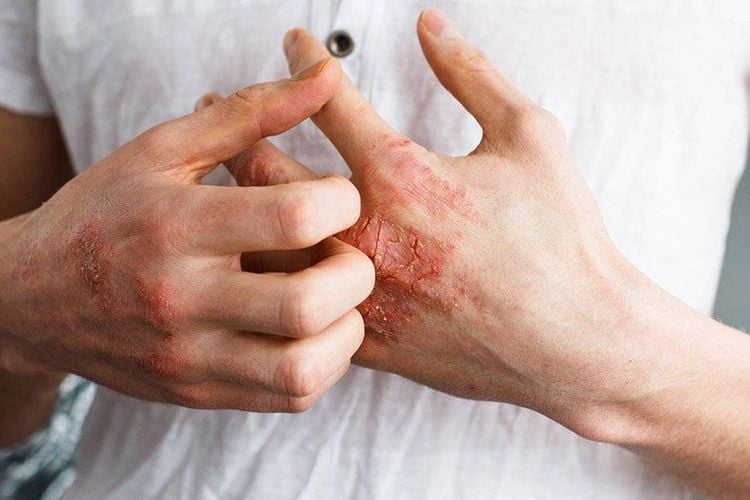This is an automatically translated article.
After about 3-4 weeks of being infected, syphilis lesions begin to appear on the patient's skin. These lesions are usually located in places such as the labia majora, labia minora, vagina, glans, penis, etc., after about 3-6 weeks, they disappear.1. How is syphilis transmitted?
Syphilis is a social disease, causing psychological guilt, affecting the health of patients. This is also a very contagious disease that needs proper prevention to avoid dangerous complications.Many people still don't know how syphilis is transmitted, which makes prevention more difficult. The routes of transmission of syphilis include:
Through unprotected sex: 95-98% of people with syphilis are infected by sexual partners. The skin and mucous membranes on the genitals of the patient are often damaged, the sores secrete a lot of fluid containing syphilis spirochetes. In addition, other contacts such as oral sex can also cause infection. Indirect syphilis infection: Although this route of infection is uncommon, it is entirely possible. When there is contact with the personal items of an infected person such as sharing underwear, personal items, toilets and towels... These items can contain syphilis bacteria and spread to the patient. Good people share furniture. Besides, if a person with syphilis lives with a healthy person, just a small scratch in contact with the object of a healthy person will be very easy to infect syphilis bacteria. Transmission through blood transfusion: If a person has blood that carries syphilis spirochetes, the recipient will also carry the disease. An infected person will not have early stage symptoms of syphilis but directly have stage 2 symptoms of the disease. Syphilis is transmitted from mother to child through the placenta and birth canal: If a pregnant woman has syphilis without timely detection and treatment or incomplete treatment, syphilis bacteria can enter the placenta through the placenta. fetus infects the fetus. When a fetus is born vaginally and the mother has previously been infected with syphilis bacteria, the syphilis bacteria can be transmitted to the fetus leading to the baby being infected with syphilis bacteria.

Có nhiều người vẫn không biết bệnh giang mai lây qua đường nào
2. How long after syphilis lesions appear?
After an incubation period of 2-4 weeks, syphilis will progress in three stages.In the first stage: That is, after about 3-4 weeks of infection, lesions begin to appear on the patient's skin. These lesions are usually located in places such as labia majora, labia minora, vagina, glans penis, penis... These lesions are local ulcers, round or oval in size 0.3 - 3cm, smooth, red, no itching, no pain, no pus; Hard sore bottom, swollen lymph nodes on both sides of the groin. These symptoms will disappear after about 3 - 6 weeks, but the disease continues to develop with other manifestations in the 2nd stage. In the 2nd stage: After having a local ulcer from 6-9 months, it will appearance of a symmetrical, peach-like pink (peach rash) rash that is not itchy. The red, pink or purple peach rash, when pressed, disappears, does not rise on the surface of the skin, does not scab, and will go away on its own. Syphilis can cause the appearance of papules, blisters, sores on the skin and mucous membranes. Stage 3: Stage 3 syphilis can occur about 3-15 years after the symptoms of the stage. Syphilis bacteria grow in internal organs such as the brain, liver, cardiovascular muscles ..., causing different symptoms depending on the part of the body infected with syphilis.

Giang mai có thể lây từ mẹ sang con qua nhau thai và đường sinh nở
3. Dangerous complications of syphilis
Experiencing pain in the extremities: When infected with syphilis, the patient appears to feel pain, especially in the lower extremities. A sharp but brief pain, like a jerk or a sting. In the final stage, walking is difficult. Spasm dysfunction: Syphilis often damages the 2nd - 4th vertebrae in the back, affecting urinary function. Patients always feel the need to urinate but cannot urinate, leading to urinary retention and incontinence. Effects in the eye area: Syphilis bacteria have the ability to attack the eye mucosa, causing the patient to have abnormalities in the pupil of the eye. It causes the pupils to be narrow, which is not normal. Loss of light reflection, causing blurred vision. Osteoarthritis: Hips, knees and ankles, even in the vertebrae and upper extremities, are the organs most affected. The joints are constantly damaged leading to changes in bone structure, causing hernias and fractures. Affects internal organs: If syphilis is not treated, the spirochetes will eat into the internal organs, causing dangerous complications such as heart failure, immediate death. For pregnant women: Syphilis can be transmitted from mother to child. Therefore, during pregnancy, a woman infected with syphilis can infect the fetus, causing congenital syphilis, birth defects or death.4. How to deal with syphilis?
Syphilis causes unpleasant symptoms, directly affecting the life, activities and health of the patient. Therefore, when there are symptoms of the disease, it is necessary to immediately go to a medical facility to find the right disease, the level of the condition, from which there is an appropriate treatment.After diagnosing and determining the treatment regimen for syphilis, the patient should strictly follow the doctor's instructions, do not arbitrarily use drugs that make the disease more serious. Especially after the end of the treatment course, it is necessary to have regular check-ups and periodic tests to detect early whether the disease has recurred.
Patients also need to keep clean, eat, rest and relax appropriately to strengthen the body's resistance.
Vinmec International General Hospital offers a Package of Examination and Screening for social diseases to help customers detect diseases early and have effective treatment and prevent dangerous complications. The screening package for social diseases at Vinmec is for all ages, both men and women.
To register for examination and treatment at Vinmec International General Hospital, you can contact Vinmec Health System nationwide, or register online HERE.
MORE:
Syphilis: Causes, transmission, signs Syphilis can be transmitted from mother to baby through the placenta When should you think about getting tested for a sexually transmitted disease?













